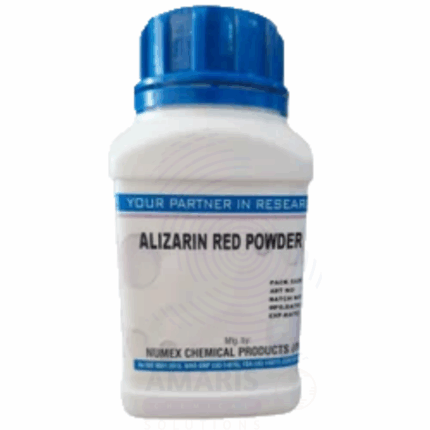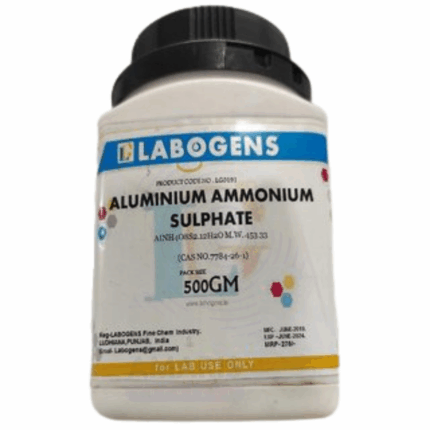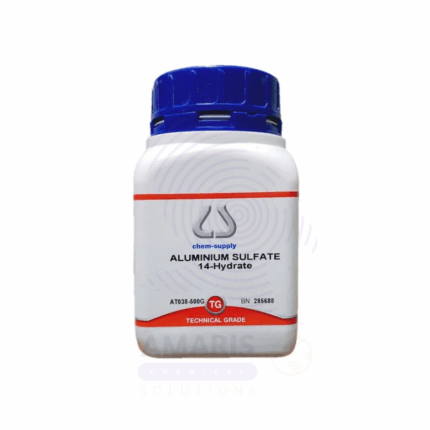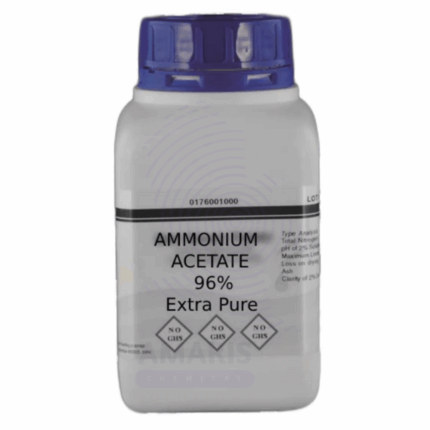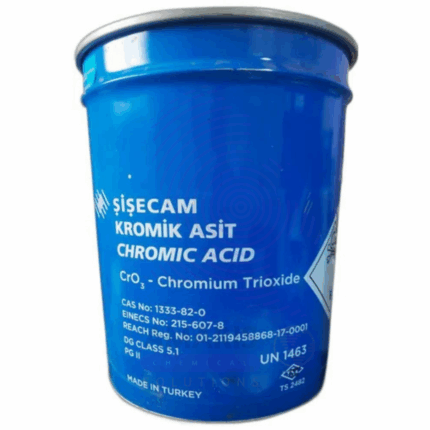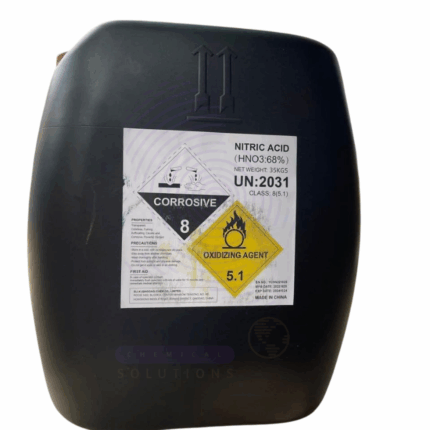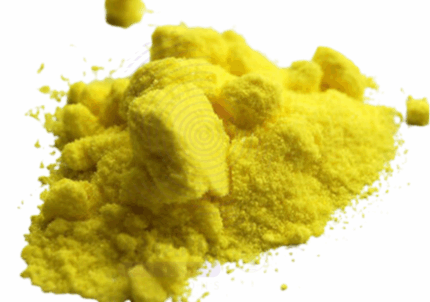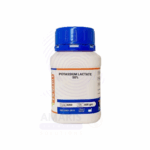
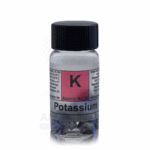
Potassium Metabisulphite Extra Pure
$ 19.10 Original price was: $ 19.10.$ 18.94Current price is: $ 18.94.
Potassium Metabisulphite Extra Pure is a white crystalline powder with a sharp sulfurous odor, valued for its powerful antioxidant and preservative properties. In the food and beverage industry, it is commonly used as a sterilizing agent, particularly in winemaking and brewing, to inhibit unwanted microbial activity and preserve color and flavor. In laboratory settings, it serves as a reducing agent and a source of sulfur dioxide. Its extra pure grade ensures minimal impurities, making it ideal for applications that demand high levels of chemical stability, such as pharmaceuticals, cosmetics, and precision formulations.
Potassium Metabisulphite Extra Pure
PRIMARY USES
- Food Preservative (E224):
- Widely used in wine, fruit juices, and dried fruits as an antimicrobial and antioxidant.
- Prevents spoilage and discoloration by inhibiting bacteria, molds, and yeasts.
- Winemaking and Brewing:
- Acts as a sterilizing agent for musts and fermentation vessels.
- Prevents unwanted fermentation by wild yeasts and preserves flavor and color.
- Analytical Chemistry:
- Used as a reducing agent and source of SO₂ gas in laboratories.
- Employed in iodometric titrations and for chlorine removal in water samples.
SECONDARY USES
- Water Treatment:
- Used for dechlorination of potable water and wastewater by neutralizing free chlorine and chloramines.
- Textile and Leather Industry:
- Functions as a bleaching agent and antichlor after fabric chlorination processes.
- Photographic Industry:
- Used in the preparation of developers and fixing solutions as an oxygen scavenger.
1. Basic Identification Attributes
- Chemical Name: Potassium Metabisulphite
- CAS Number: 16731-55-8
- HS Code: 2832.20.00
- Molecular Formula: K₂S₂O₅
- Synonyms:
- Potassium pyrosulphite
- Dipotassium disulphite
- E224 (as a food preservative)
- Potassium metabisulfite
2. Physical & Chemical Properties
- Physical State: Solid (powder or crystalline granules)
- Color & Odor: White or slightly yellow; pungent sulfur dioxide-like odor
- Boiling Point & Melting Point:
- Decomposes before boiling
- Melting Point: ~190 °C (decomposes)
- Density/Specific Gravity: ~2.34 g/cm³
- Solubility:
- Soluble in water (65 g/100 mL at 20 °C)
- Insoluble in ethanol
- pH Level: Acidic (pH ~3.5–5.0 in 10% aqueous solution)
- Vapor Pressure & Volatility: Low volatility; releases SO₂ on contact with acid or moisture
- Flash Point: Not flammable
- Autoignition Temperature: Not applicable
- Viscosity: Not applicable (solid)
3. Safety & Hazard Attributes
- Hazard Class (GHS Classification):
- Irritant (skin and eye)
- Respiratory irritant
- May cause allergic respiratory reaction (asthma-like symptoms)
- NFPA Ratings:
- Health: 2
- Flammability: 0
- Reactivity: 1
- Exposure Limits:
- TLV (ACGIH): 5 ppm (as SO₂)
- OSHA PEL: 5 ppm (as SO₂)
- Reactivity:
- Reacts with acids to release sulfur dioxide gas
- Incompatible with strong oxidizers and acids
4. Storage & Handling Attributes
- Storage Conditions:
- Store in a cool, dry, and well-ventilated area
- Protect from moisture and light
- Incompatible Materials:
- Acids, water (moisture), oxidizers
- Container Type:
- Plastic or coated metal containers with moisture-proof seals
- Shelf Life & Expiration Date:
- Typically 1–2 years when stored properly
- Special Handling Requirements:
- Use gloves, goggles, dust mask or fume hood in bulk handling
- Avoid inhalation and contact with moisture
5. Regulatory & Compliance Attributes
- Regulatory Status:
- Approved food additive (E224, preservative)
- Listed in REACH, TSCA, and FDA
- Transportation Restrictions:
- Not classified as dangerous goods for transport
- Waste Disposal Method:
- Dispose according to local regulations
- Dilute and neutralize before disposal if permitted
6. Environmental & Health Impact
- Ecotoxicity:
- Toxic to aquatic organisms in high concentrations
- Risk of oxygen depletion in water due to SO₂ release
- Persistence in Environment:
- Not persistent; degrades rapidly in moist air or water
- Carcinogenicity/Mutagenicity:
- Not classified as carcinogenic or mutagenic
- Biodegradability:
- Decomposes readily in the environment to sulfate
SAFETY PRECAUTIONS
Personal Protective Equipment (PPE):
- Chemical-resistant gloves (e.g., nitrile)
- Protective goggles or face shield
- Lab coat or apron
- Use in a fume hood or well-ventilated area
Handling:
- Avoid inhalation of dust or vapors
- Prevent contact with skin, eyes, and clothing
- Avoid generating dust
- Use only with proper ventilation
Storage:
- Store in a cool, dry, and well-ventilated place
- Keep container tightly closed
- Protect from heat, moisture, acids, and oxidizing agents
FIRST AID MEASURES
Inhalation:
- Move person to fresh air immediately
- If breathing is difficult, provide oxygen and seek medical attention
Skin Contact:
- Remove contaminated clothing
- Wash thoroughly with soap and water
- Seek medical advice if irritation occurs
Eye Contact:
- Rinse thoroughly with water for at least 15 minutes
- Seek medical attention promptly
Ingestion:
- Rinse mouth thoroughly
- Do not induce vomiting
- Give water or milk if conscious
- Get medical assistance immediately
FIRE FIGHTING MEASURES
Flammability:
- Non-flammable, but may release toxic gases
Extinguishing Media:
- Use water spray, dry chemical, foam, or CO₂
Hazardous Combustion Products:
- Sulfur dioxide (SO₂), potassium oxides
Firefighter Protection:
- Wear self-contained breathing apparatus (SCBA)
- Avoid inhaling gases or fumes from fire
- Control runoff to prevent environmental contamination


 Preservatives(food)
Preservatives(food) Flavor Enhancers
Flavor Enhancers Acidulants
Acidulants Sweeteners
Sweeteners Antioxidants
Antioxidants Colorants(food)
Colorants(food) Nutraceutical Ingredients (food)
Nutraceutical Ingredients (food) Nutrient Supplements
Nutrient Supplements Emulsifiers
Emulsifiers
 Collectors
Collectors Dust Suppressants
Dust Suppressants Explosives and Blasting Agents
Explosives and Blasting Agents Flocculants and Coagulants
Flocculants and Coagulants Frothers
Frothers Leaching Agents
Leaching Agents pH Modifiers
pH Modifiers Precious Metal Extraction Agents
Precious Metal Extraction Agents
 Antioxidants(plastic)
Antioxidants(plastic) Colorants (Pigments, Dyes)
Colorants (Pigments, Dyes) Fillers and Reinforcements
Fillers and Reinforcements Flame Retardants
Flame Retardants Monomers
Monomers Plasticizers
Plasticizers Polymerization Initiators
Polymerization Initiators Stabilizers (UV, Heat)
Stabilizers (UV, Heat)
 Antifoaming Agents
Antifoaming Agents Chelating Agents
Chelating Agents Coagulants and Flocculants
Coagulants and Flocculants Corrosion Inhibitors
Corrosion Inhibitors Disinfectants and Biocides
Disinfectants and Biocides Oxidizing Agents
Oxidizing Agents pH Adjusters
pH Adjusters Scale Inhibitors( water)
Scale Inhibitors( water)
 Antioxidants(cosmetic)
Antioxidants(cosmetic) Emollients
Emollients Fragrances and Essential Oils
Fragrances and Essential Oils Humectants
Humectants Preservatives
Preservatives Surfactants(cosmetic)
Surfactants(cosmetic) Thickeners
Thickeners UV Filters
UV Filters
 Fertilizers
Fertilizers Soil Conditioners
Soil Conditioners Plant Growth Regulators
Plant Growth Regulators Animal Feed Additives
Animal Feed Additives Biostimulants
Biostimulants Pesticides (Herbicides, Insecticides, Fungicides)
Pesticides (Herbicides, Insecticides, Fungicides)
 Active Pharmaceutical Ingredients (APIs)
Active Pharmaceutical Ingredients (APIs) Excipients
Excipients Solvents(pharmaceutical)
Solvents(pharmaceutical) Antibiotics
Antibiotics Antiseptics and Disinfectants
Antiseptics and Disinfectants Vaccine Adjuvants
Vaccine Adjuvants Nutraceutical Ingredients (pharmaceutical)
Nutraceutical Ingredients (pharmaceutical) Analgesics & Antipyretics
Analgesics & Antipyretics
 Analytical Reagents
Analytical Reagents Solvents(lab)
Solvents(lab) Chromatography Chemicals
Chromatography Chemicals Spectroscopy Reagents
Spectroscopy Reagents microbiology-and-cell-culture-reagents
microbiology-and-cell-culture-reagents Molecular Biology Reagents
Molecular Biology Reagents Biochemical Reagents
Biochemical Reagents Inorganic and Organic Standards
Inorganic and Organic Standards Laboratory Safety Chemicals
Laboratory Safety Chemicals Specialty Laboratory Chemicals(Special Laboratory Equipment)
Specialty Laboratory Chemicals(Special Laboratory Equipment)
 Demulsifiers
Demulsifiers Hydraulic Fracturing Fluids
Hydraulic Fracturing Fluids Scale Inhibitors(oil)
Scale Inhibitors(oil) Surfactants(oil)
Surfactants(oil) Drilling Fluids
Drilling Fluids
 Dyes and Pigments
Dyes and Pigments Bleaching Agents
Bleaching Agents Softening Agents
Softening Agents Finishing Agents
Finishing Agents Antistatic Agents
Antistatic Agents
 Admixtures
Admixtures Waterproofing Agents
Waterproofing Agents Sealants and Adhesives
Sealants and Adhesives Curing Compounds
Curing Compounds Concrete Repair Chemicals
Concrete Repair Chemicals Anti-Corrosion Coatings
Anti-Corrosion Coatings
 Surfactants(cleaning)
Surfactants(cleaning) Builders
Builders Enzymes
Enzymes Solvents (Cleaning)
Solvents (Cleaning) Fragrances
Fragrances
 Electronic Chemicals
Electronic Chemicals Catalysts
Catalysts Lubricants
Lubricants Photographic Chemicals
Photographic Chemicals Refrigerants
Refrigerants Automotive chemicals
Automotive chemicals Pyrotechnic Chemicals
Pyrotechnic Chemicals
 Biodegradable Surfactants
Biodegradable Surfactants Bio-based Solvents
Bio-based Solvents Renewable Polymers
Renewable Polymers Carbon Capture Chemicals
Carbon Capture Chemicals Wastewater Treatment Chemicals
Wastewater Treatment Chemicals
 Pigments
Pigments Solvents(paint)
Solvents(paint) Specialty Coatings
Specialty Coatings Binders/Resins
Binders/Resins Additives
Additives Driers
Driers Anti-Corrosion Agents
Anti-Corrosion Agents Functional Coatings
Functional Coatings Application-Specific Coatings
Application-Specific Coatings
 Fresh Herbs
Fresh Herbs Ground Spices
Ground Spices Whole Spices
Whole Spices Spice Blends
Spice Blends Dried Herbs
Dried Herbs
 Leavening Agents
Leavening Agents Dough Conditioners
Dough Conditioners Flour Treatments
Flour Treatments Fat Replacers
Fat Replacers Decoratives
Decoratives Preservatives(baking)
Preservatives(baking)
 Plasticizers & Softeners
Plasticizers & Softeners Reinforcing Agents
Reinforcing Agents Adhesion Promoters
Adhesion Promoters Vulcanizing Agents
Vulcanizing Agents Antidegradants
Antidegradants Blowing Agents
Blowing Agents Fillers & Extenders
Fillers & Extenders Accelerators & Retarders
Accelerators & Retarders

